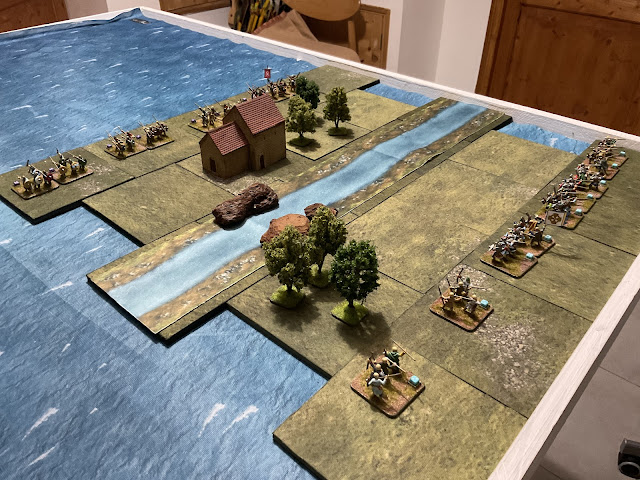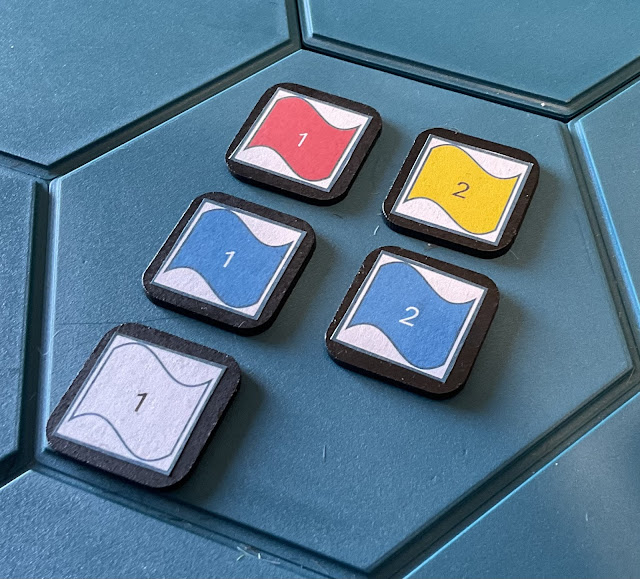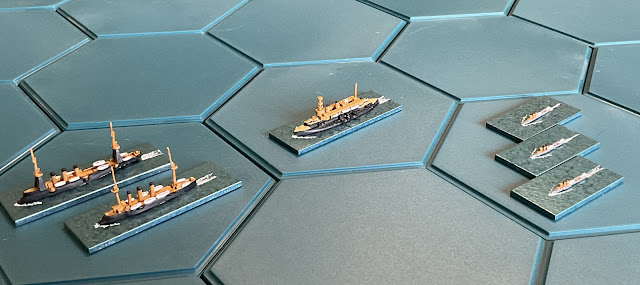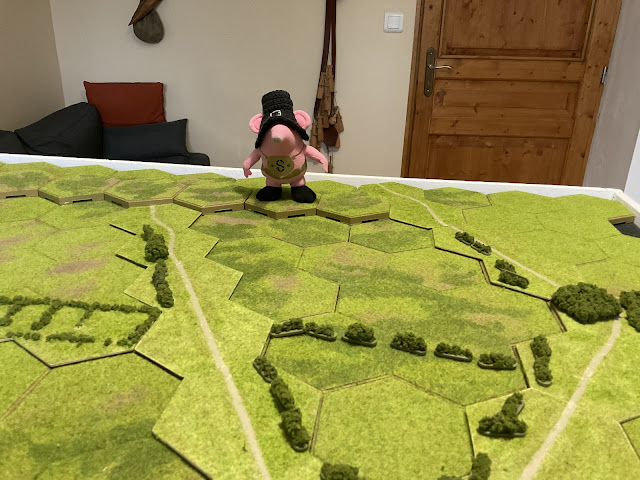Bugger me it’s November already. Where the hell did October go? All the leaves are off the fruit trees and we are down to 1 egg a day so it’s definitely autumn despite the sunshine.
Although I’ve another naval game in the pipeline I thought I’d take the opportunity to bring you up to speed with matters military here at La Maison Broom.
First off, my recent dive into the depths of the lead pile unearthed a little treasure trove of Wiglaf miniatures 18mm Saxons. I’ve been painting away like a busy little squirrel ever since and this is where we are so far.
 |
| 7th century Saxons in 18mm - discovered hiding in the lead pile. |
The plusses are that I already have the terrain and the rules to use with these chaps, so apart from a few more packs of personality figures I should be good to go. The minuses are that I discovered Kalistra 10mm Romans lurking in the lead pile while digging as well. I had hoped to order some of the 3d printed ones recently showcased by Keith on his Bydand blog - but the Kalistra lads are already here so it makes more sense to persevere with them I suppose.
This latest scouring of the lead pile has made me realise how fixated on a project I can become, and also how quickly this then seems to turn into a form of burnout and disinterest.
What I need to do (and I’m sure the Current Mrs Broom was referring to my wargaming when I went up to bed the other night) is to spice things up a bit ;-). You know the drill, different scales, different periods, go where angels fear to tread and all that. Maybe try and have more than one project on the go that I can flip back and forth to.
Maybe, oh I don’t know, something like…this…
Or this…
 |
| Empress Miniatures 28mm Indian Mutiny range |
Oh my God they look so good…
Of course it’d mean all new terrain and the figures are ruddy expensive but I’ve got a set of rules to use, so there’s that. I mean okay so I’ve been trying to cut costs, but for gods sake I could be run over by the bus tomorrow and have never even tried these.
It’d mean a move towards skirmish gaming with The Men Who Would Be Kings and no hexes but it’d snap me out of my “I’ve got no room for gaming so I’ll only buy small minis,” rut.
Nah.
Cmon. It makes no sense at all. What am I thinking?
But they do look soooooo good…don’t they?
Okay, enough with the levity and the ho ho ho’s.
As you may recall I had the summer off from blogging in order to recharge the old batteries. It involved a fair amount of time with chickens (anytime spent with chickens is time well spent, trust me) but I also went for a wander or two around the outskirts of my hamlets parent village (St Dizier Leyrenne - yeah you can google earth it if you like, it’s not like I’m going to know, now is it?).
It was July 19th and I was nearing the end of a pleasant stroll through the woods when I came across this.
And just like that I fell down the local history research rabbit hole that I referred to a couple of posts ago.
By mid 1944 the German army had been bled white. The units left “occupying” France were by and large a hodgepodge of signal troops, SD, Gestapo, recuperating units from the eastern front and so on. You get the drift.
Just after the invasion, orders were received to begin an anti partisan sweep in my department. Despite the supply and man power problems experienced by the Wehrmacht, 2500 troops, 110 vehicles and 7 “cannon” were formed into Brigade Jesser, and this caravan of retribution then burned and looted its way through my local area for about 2 months
On 16th July 1944 they arrived at the entrance to Bourganeuf, which is my nearest town. Here they were confronted by Capitaine Jaques Chapou and elements of his CFI partisan group.
 |
| According to locals Capitaine Chapou was shot here on the approach to the town while preparing an ambush, and a number of his men were duly captured. Zee Germans would have been approaching from the top of the picture. |
Given the numbers involved the partisans were soon overwhelmed with the Capitaine going down in a hail of fire. 12 resistance fighters were captured and imprisoned in the Zizim tower until the follow up SD units could arrive. The official version is that these men were deported to Germany - though none were ever seen again.
 |
| The tower of Zizim in the town square - left of picture. Built in the 15th century to house a captive Ottoman prince. You know… like you do. |
The Rue de Verdun was sealed off at both ends and families dragged out into the street to be searched and generally roughed up. My neighbour Solange was only 9 at the time and she still remembers it well. I guess you would.
 |
| Rue de Verdun - then |
 |
| And now… |
On the 19th July Brigade Jesser arrived in my little hamlets parent village (St Dizier Leyrenne) with over 40 trucks parking on the village green pictured below.
 |
| The 1944 Saint Dizier Leyrenne truck stop. |
The accompanying SD detachment set themselves up in front of the monument slightly to the left of the picture and began their interrogations. There were less than 500 people resident in the village and surrounding farms. 61 people (apparently selected at random) were arrested and deported to the Reich for further investigation. Only 2 returned after the war.
I can only assume that the interrogators from the SD were fairly efficient because somehow later that evening a company of soldiers surrounded 8 of Capitaine Chapou’s partisans who’d avoided the roundup in Bourganeuf and were attempting to escape the area through the woods to the north of my house.
The soldiers involved were Crimean Tartar “volunteers” in the Russian legion and they brought with them all the excesses and barbarism of the Eastern Front. The 8 partisans were captured, tortured for information and then executed on the spot.
 |
| Crimean Tartars of the Russian Volunteer LegIon in France 1944] |
So yeah, it was exactly 80 years later to the day, on the 19th July 2024 that I was wandering through the nearby woods and I discovered the memorial. I was alone and the woods were silent. It all felt very sad. Apparently there are flowers left each year. Next year I shall add to them.
Some of the Tartars responsible for this outrage mutinied on the 29th July and actually, while out of my area, volunteered to join a resistance group in the Corrèze region. Their fate after this point remains unknown. The rest of the unit eventually met their end in the Colmar pocket.
Kurt Jesser was captured in October 1945 and held in a camp to be charged for war crimes. He was released in 1947 and all charges were dropped. A further investigation was launched in 1949 (perhaps when further information came to light?) but again the charges were dropped. He died at home in 1950.
Now, if you want “grim” on a larger and even more barbaric scale try googling Oradour Sur Glane which is also not too far away and well worth a visit.
Toodleooh.












































